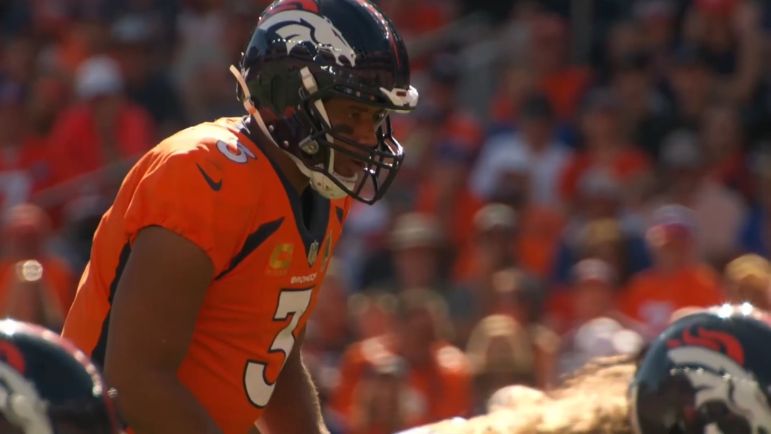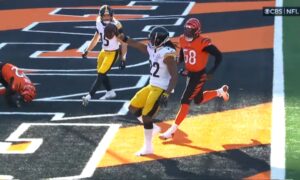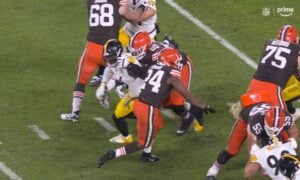The Pittsburgh Steelers all-in investment on the offensive line is multi-fold. A core belief that games are won up front. Andy Weidl’s experience building the trenches and turning the Philadelphia Eagles into a contender. Improving the run game, the foundation of this offense, and giving Najee Harris and Jaylen Warren the best group to produce behind. But a sturdy o-line also protects the quarterback. It buys them more time, reduces hits and boosts the passing game. That’s obvious enough.
Presumed starter Russell Wilson will feel that benefit, but he’ll need to tweak his style to truly change his outcomes.
As we’ve noted since he was signed, Wilson’s biggest knocks are the sacks he takes, how long he holds onto the football and the consequences that come with that. There are benefits, as he’s still mobile enough to create and find an open man. But it’s a key reason why he takes the sacks and negative plays that he does.
Using NextGenStats, Wilson consistently has among the longest snap-to-throw times. It doesn’t matter the team or system, the numbers are similar.
Russell Wilson’s Snap-To-Throw Times (2019-2023)
| Year | Throw Time | NFL Rank |
|---|---|---|
| Russell Wilson (2023) | 3.06 seconds | 3rd-Longest |
| Russell Wilson (2022) | 2.98 seconds | 7th-Longest |
| Russell Wilson (2021) | 2.80 seconds | 21st (of 39) |
| Russell Wilson (2020) | 2.97 seconds | 5th-Longest |
| Russell Wilson (2019) | 2.85 seconds | 12th-Longest |
The results are consistent. At best, he’s come in at 2.8 seconds. At worst, over 3 seconds. And the last two seasons has been his longest time in the pocket under two different coaching staffs, Nathaniel Hackett and Sean Payton, the latter of whom doesn’t create a system where quarterbacks hang onto the ball.
Conventional wisdom says the ball should get out in 2.5 seconds. The reality is almost no quarterback does that. Only two averaged under that mark in 2023, Tua Tagovailoa (2.36 seconds) and Mac Jones (2.46 seconds). Granted, that includes scramble drills and extended plays that aren’t the norm but skew numbers upward, making anyone who even hovers around that mark in the right area. But Wilson isn’t close. With those numbers, it doesn’t matter much who the left tackle is if the ball doesn’t come out in 3 seconds. Wilson is going to take shots.
That’s where Pittsburgh will need to implement structure. It’s in Wilson’s nature to leave the pocket, run around and make a play. Partially because of the athleticism he’s had throughout his career, and partially due to a lack of height that made it tough to see in the pocket.
Sacks aren’t purely an indication of o-line play. It’s a team stat. Some sacks are on the offensive line, some on the running backs, some on the play call, some on the wide receivers and some on the quarterback. Blame is shared.
It’s not about radical change or making Wilson someone he isn’t. But Arthur Smith’s job is to create a rhythm that works with what Wilson’s skillset supports, and to encourage him to get the ball out faster. Part of the reason why Myles Garrett has been seemingly so ineffective against the Steelers is because of Pittsburgh’s clear effort to get the ball out ultra-quick when he’s on the field. They don’t use play-action when he’s out there. When George Pickens caught his 71-yard touchdown last season, it came when Garrett was on the sidelines. Dan Moore hasn’t locked down Garrett. He’s been toasted like every other left tackle. The game plan is just designed for the ball to come out in 2 seconds, making it near-impossible for Garrett to get home. At minimum, Wilson has to change in those moments.
If he can’t, there will be a lot of sacks and 3rd-and-longs. Wilson will have to elevate his game as a passer all the more to compensate for it. Expecting him to have a quick release is unrealistic. It’s not going to happen, and the Steelers would be fools to even try. But getting his snap-to-throw time down to even an average target — about the 2.80 seconds he had in 2021 with Seattle — is manageable. That was his last Pro Bowl year, throwing 25 touchdowns, only 6 interceptions and was sacked just 33 times. If he can have that stat line in Pittsburgh, he’s going to have a successful year and remain the Steelers’ quarterback come 2025.








